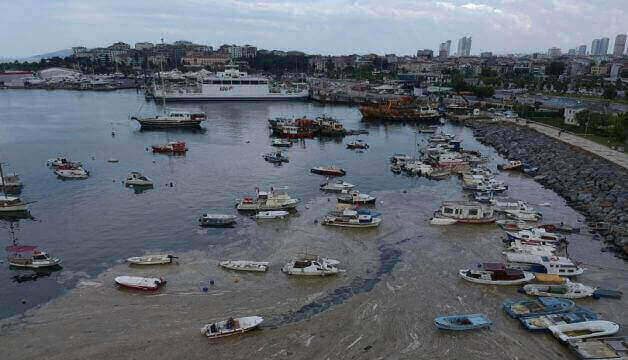Last Updated on: 5th June 2021, 11:16 pm
Thick, brown, and bubbly foam known as the “Red of the sea” has covered the shores of the Sea of Marmara, alerting the people of Istanbul and threatening marine life.
Natural slime was first documented in Turkey in 2007 when it was also observed in parts of the Aegean Sea near Greece. But this outbreak is the largest in history, which experts attribute to a combination of pollution and global warming that accelerates the growth of the algae responsible for the slimy sludge.
“Of course it affects our work,” said Fischer Mahsum Daga, 42, as the slimy substances crushed rows of the surrounding boats.
Do you know what it does with shellfish?
When they open, it prevents them from closing as it gets in the way. All the sea slugs here are dead. Istanbul University biology professor Muharrem Balci said that if algae get out of control in the spring, like this year, they block the sun and cause a lack of oxygen for fish and the sea.
“Sea snot” results from a kind of nutrient overload for algae enjoying the hot weather and water pollution that has gradually worsened over the past 40 years, Balci said.
“This slime is now covering the ocean surface like a tarpaulin,” Balci told AFP. “After a while, this blanket collapses to the ground and covers the ecosystem (of the seafloor).”
“It could poison clams and marine life such as crabs. It will smell like a rotten egg if this process isn’t stopped,” he said.
Plan of Action
Cevahir Efe Akcelik, environmental engineer and general secretary of the Union of Chambers of Turkish Engineers and Architects, said the foam could cover the sea all summer if urgent measures are not taken.
“Studies show that the slime is now not only on the surface but also 25 to 30 meters deep,” he told AFP.
The Sea of Marmara, which stretches along the south coast of Istanbul from the Bosporus to the Aegean Sea, is densely populated and is home to many industrial sites. Balci said it also absorbs some of the waste that drains into the Black Sea alongside the polluted Danube that flows through Eastern Europe.
“This is an additional burden for the Marmara Sea,” said Balci and called for a joint action plan for all coastal cities of the sea.
Workers attempt to remove the sludge with nets, but their efforts so far have proven largely ineffective. Balci said a permanent solution will require adequate marine surveillance, biological and chemical disposal systems for cities and industrial areas at sea.
Ali Oztunc, an MP for the largest opposition party, the CHP, called on the government to impose harsh penalties on waste disposal facilities that do not obey the rules.
|The Sea of Marmara is an inland sea, but unfortunately, it is becoming an inland desert due to poor environmental policies,” he told AFP.
On Tuesday, President Recept Tayyip Erdogan’s ruling coalition rejected a CHP proposal to set up a parliamentary commission to investigate |Red of the Sea”.
Ozuna also called on Erdogan’s government to finally approve the 2015 Paris Agreement, which aims to limit rising temperatures by reducing CO2 emissions. “The government should approve the Paris Agreement immediately,” said Oztunc.



